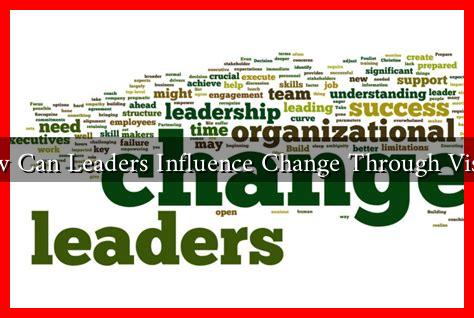-
Table of Contents
How Can Leaders Influence Change Through Vision
In today’s fast-paced and ever-evolving world, the ability to influence change is a critical skill for leaders across all sectors. A compelling vision serves as a guiding star, helping organizations navigate through uncertainty and challenges. This article explores how leaders can effectively influence change through a well-articulated vision, supported by examples, case studies, and relevant statistics.
The Power of Vision in Leadership
A vision is more than just a statement; it is a powerful tool that can inspire and motivate individuals and teams. A clear vision provides direction, fosters alignment, and encourages commitment among employees. According to a study by the Gallup Organization, organizations with a strong sense of purpose and vision see 30% higher employee engagement levels.
Characteristics of an Effective Vision
For a vision to be effective, it must possess certain characteristics:
- Clarity: A vision should be clear and easily understood by all stakeholders.
- Inspiration: It should evoke passion and enthusiasm among team members.
- Future-oriented: A vision must focus on long-term goals and aspirations.
- Feasibility: While ambitious, it should also be realistic and achievable.
Communicating the Vision
Once a vision is established, effective communication is crucial. Leaders must ensure that the vision is communicated consistently and frequently. Here are some strategies for effective communication:
- Storytelling: Use narratives to illustrate the vision and make it relatable.
- Visual Aids: Incorporate visuals such as infographics or videos to enhance understanding.
- Engagement: Encourage feedback and discussions to foster a sense of ownership among team members.
Case Study: Microsoft’s Transformation Under Satya Nadella
One of the most notable examples of visionary leadership is Satya Nadella’s transformation of Microsoft. When he took over as CEO in 2014, the company was struggling with stagnation and a lack of innovation. Nadella introduced a new vision centered around a “mobile-first, cloud-first” strategy. He emphasized empathy, collaboration, and a growth mindset, which revitalized the company culture.
Under his leadership, Microsoft’s market value soared from $300 billion to over $2 trillion, demonstrating the profound impact of a clear and compelling vision. Nadella’s approach not only influenced change within the organization but also positioned Microsoft as a leader in the tech industry.
Empowering Employees to Embrace Change
Leaders must also empower their employees to embrace the vision and drive change. This can be achieved through:
- Training and Development: Invest in employee growth to align their skills with the vision.
- Recognition: Acknowledge and reward contributions that align with the vision.
- Autonomy: Allow employees the freedom to explore innovative solutions that support the vision.
Measuring the Impact of Vision on Change
To understand the effectiveness of a vision in influencing change, leaders should establish metrics to measure progress. Key performance indicators (KPIs) can include:
- Employee engagement scores
- Retention rates
- Productivity levels
- Customer satisfaction ratings
Regularly reviewing these metrics can help leaders adjust their strategies and ensure that the vision remains relevant and impactful.
Conclusion
In conclusion, leaders play a pivotal role in influencing change through a well-defined vision. By articulating a clear, inspiring, and feasible vision, communicating it effectively, and empowering employees, leaders can foster a culture of innovation and adaptability. The case of Microsoft under Satya Nadella exemplifies how visionary leadership can transform an organization and drive significant change. As the business landscape continues to evolve, the ability to influence change through vision will remain a vital skill for leaders seeking to navigate the complexities of the modern world.

